“How do you figure out construction quality when walking through an RV?”
And I’m not talking about a 4-hour, in-depth, pen-and-pencil, flashlight and screwdriver, 72-point inspection at the local dealership before final purchase. If you only have five minutes to explore an RV camper at an RV show, how do you get a sense of the construction quality?
Recently, I walked through, crawled under, and climbed on top of more than 100 campers at the 2021 Pittsburgh RV Show – and I did it all for you, Reader!
I’m going to give you a litmus test.
Here are more than 50 quick indicators of construction quality that you can see just by walking through a unit in 5 minutes or less.
BEFORE YOU BEGIN …
1. Research Your Dealership!
Yes, this really is the first place you should start!
RV service isn’t like automotive service. You can’t just waltz into your neighborhood RV mechanic, ask for a checkup and be on your way in 45 minutes.
There aren’t enough service dealerships to deal with the glut of RVs and campers. Waiting lists can easily be 3-6 weeks, even 3-6 months in the busy season! Because of this, dealers service their customers first.
Also, consider the RV manufacturer’s warranty. Some manufactures will only approve warranty reimbursements and coverage if the vehicle is serviced by a dealer within their network.
A bad dealer can make your life hell as an RV owner. Research your dealer!
- Check out their website
- Understand their pricing structure
- Read over their financing options
- Read customer online reviews
- Visit the dealership in person
If possible, do all this before attending the show!
2. Know Your Tow Vehicle
First, you should understand the towing, cargo and travel capacities of your current tow vehicle. You can find your factory-rated towing capacity on the VIN sticker on the inside of your door jamb. Also, is your vehicle capable of fifth-wheel towing, or just bumper-pull?
You can visit the Towing Weight Calculators at Changing Gears to learn what your vehicle can tow!
Second, you should consider if you’re willing to trade in for a larger tow vehicle. Most RVs, especially fifth-wheels, are best towed with a three-quarter-ton truck or body-on-frame SUV. Consumer pickup trucks (e.g., F-150) are only suited for smaller towables.
If you’re looking for a van or motorhome, you can skip this step.
3. Understand Your RV Niche
I hate to say it, but on average, the typical toy hauler or motorhome is better quality than a travel trailer.
It’s simple marketing demographics. If you’re buying a 36-foot toy hauler behemoth for your spankin’ new ATVs, the manufacturer knows you’ve got money, and you’re willing to spend it.
Same reasoning if you’re buying a custom Sprinter van conversion or a fifth wheel that needs an F250 dually to pull it.
No such guarantee exists when you’re buying an entry-level 26-ft travel trailer.
So try to make quality comparisons based on the size and style of your target camper or RV.
Some common RV and camper types include:
- Travel trailer
- Truck camper
- Toy hauler
- Pop-ups/A-frames
- Park Model (THOW)
- Fifth-wheel
- Class A motorhome
- Class C van
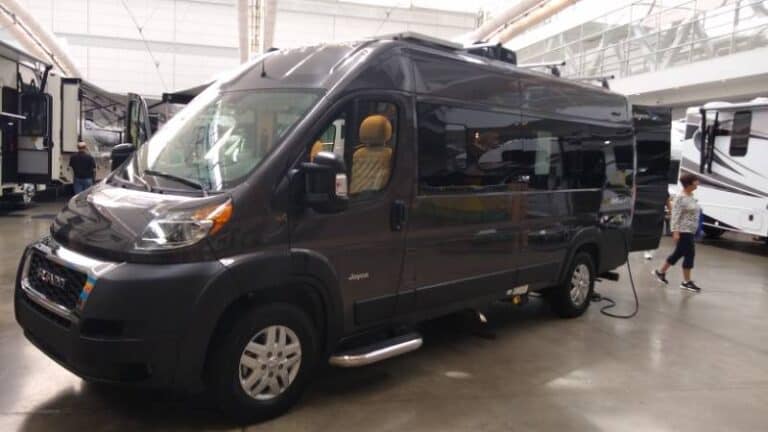


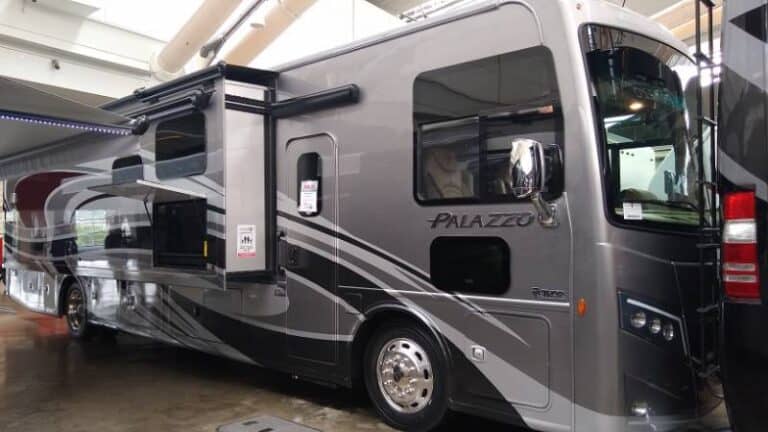
2. Ignore the Sales Hype
Words like “family-friendly,” “Arctic,” and `“Ultralight,” unfortunately, mean very little. Yes, some manufacturers take these descriptions seriously. Others just wrap their tanks in Reflectix and tack on the “Arctic Package” for $599.
In fact, here’s an article I wrote that tells you exactly how much lighter an “ultralight” camper is!
Do your own research. Bring a smartphone with you so you can look up facts and reviews in real-time. Jot down notes for further research when you get back home.
You see, RV shows are organized by and for dealerships, not manufacturers. Don’t expect to find all brands represented! You’re likely to only see brands carried by the local dealerships, or those within a few hours.
Some – not all – dealerships may hire temporary salespeople to cope with the show workload. A few of these temps have extensive experience selling RVs. Most do not. They just parrot whatever 10-point list they memorized three hours before the doors opened. Generally, they know more about financing than about RVs.
If the salesperson can’t answer your question, ask to speak to the sales manager or brand representative. They’ll have much more in-depth knowledge.
What looks like a plethora of RV companies is really only a plethora of brands. Two companies – Thor Industries and Berkshire Hathaway – own more than 250 RV brands!
You’ll see a handful of smaller companies like Grand Design (owned by Winnebago) and boutique independent manufacturers, but otherwise, Thor and Berkshire are the Mom n’ Pop of the RV family.
5. Check Your HGTV Expectations at the Door
People have an intuitive sense for what makes a high-quality house; after all, you walk thru houses every day! Everyone knows that threadbare carpet, single-pane windows, and leaky faucets make a cheap house.
You probably don’t have this gut-knowledge with RVs. So you need to take the time to educate yourself.
It’s a common saying that layouts and colors sell campers. Don’t be that guy. Don’t spring for a camper just because you’ll die if you don’t have that exact layout. Things like valances and backsplashes are good for RV shows, not for RV living.
With that, let’s begin!
Quality Walk-Thru: EXTERIOR
Let’s start at the exterior.
What’s the price tag? Is it comparatively cheap for its size? Then you’re looking at a cheaply built camper. No ifs, ands or buts.
There’s no magical way to build a better camper for less. Especially not when the major manufacturers are looking to shave dimes off the Bill of Materials.
That $38,000 28-ft trailer will almost certainly be better built than the $27,000 one at the same length. Even if they look almost the same on the inside, I’d almost guarantee you the mechanical guts of the $35,000 are superior.
But let’s look beyond the price tag. If you’re comparing two campers reasonably close in size and style, how can you tell which is better?
Can you guess the type of construction? Is it built with stick n’ tin construction, laminated sidewalls, or a welded superstructure?
Stick n’ tin models are normally built for the budget market (with a few exceptions). But some are better than others. Read the brochure. See what kind of insulation is used in the walls? It is cheap fiberglass or more reliable solid foam or spray foam?
By the way, here’s an article about RV insulation myths I wrote for my friend Ashley Mann at RVInspiration.com!
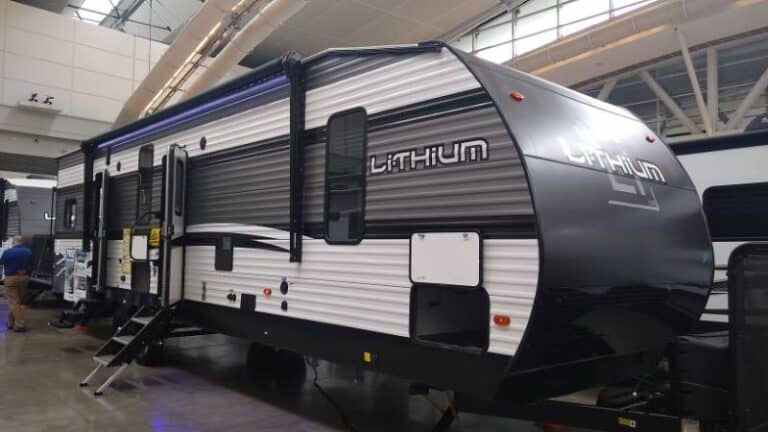
If the camper has laminated sidewalls, I like to see a solid fiberglass front cap with lower diamond plate rock protection. Corrugated siding on the front wall makes me nervous – those siding S-lock seams are prime suspects for wind-driven rain leaks. Double my nervousness if there’s an uncovered front window, too.
Oh, and inspect the trim caulking. If the non-sag caulking around windows and roof-edge trim is thin, sloppy or non-existent, then you know the camper was probably rushed down the production line.
You can’t tell from the outside, but you need to ask if the roof-edge seams are taped. Too many manufacturers just use butyl tape underneath the aluminum moulding. That’s lazy. Taped seams are proven to significantly reduce the likelihood of an RV roof leak.
Are there lots of sidewall windows? Windows allow natural light, ventilation, clean air and a sense of openness. Cheap campers have smaller vertical or horizontal-slider windows. Fixed (picture-frame) windows are even cheaper.
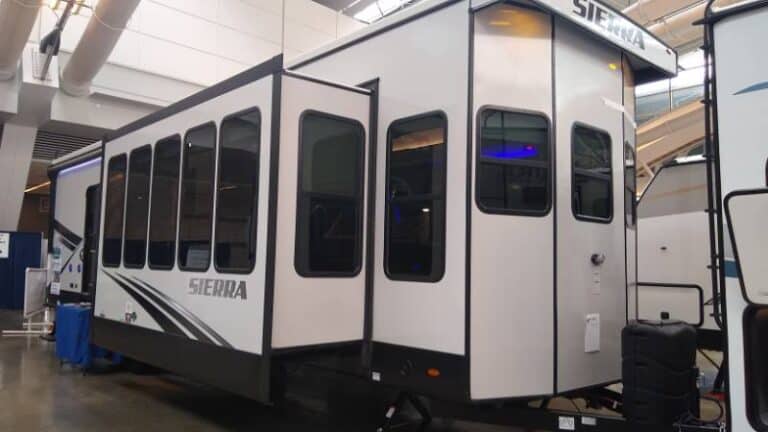
Don’t get distracted by the sales “features,” like frameless windows, screen doors, slide-outs, awnings, etc. Those are options, not indications of build quality.
But you should open the front door all the way! Does it hit anything? Is there a stop or bumper? Or does it crash into the sidewall?
Something else I look for: The water and power inlet locations. If they’re scattered all over the wall and not properly marked, that infers the floorplan wasn’t well thought-out.
I like to see the inlets co-located in an accessible location, preferably with a convenience light nearby. That tells me the designer took the extra time to properly locate and route the water lines and wires.
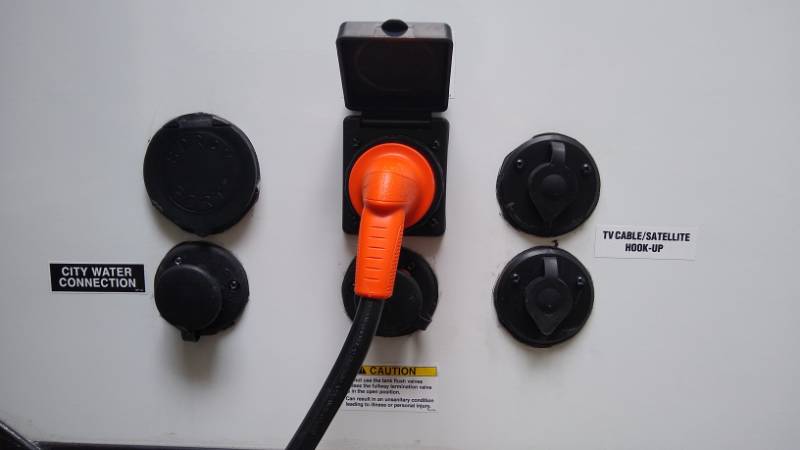
Luxury units might even have all-in-one water and/or power management systems, like the Nautilus lineup.

FYI, make sure there’s a black tank rinse. You’ll thank me later.

I like to look inside the cargo compartments. The fit n’ finish inside will tell you a lot about the brand’s attention to detail! If you see lots of waned, warped 2×2 lumber held together with staples as the bed frame, you can be sure the rest of the framing looks like that, too.
I like to see 2×2 frames screwed, not stapled, or welded aluminum tube frames.
If you can, shine a flashlight at the framing surrounding the cargo door cutout. You’ll see one of four materials:
- Nothing: Not a good sign! Likely to leak in the future.
- Bare wood: Good screw retention, but no water protection.
- Painted wood: Good screw retention AND water protection.
- Aluminum: Best!
Quality Walk-Thru: UNDERNEATH
Is the underbelly enclosed?
Normally, that means there’s floor insulation and extra protection – but not always!
If the underbelly isn’t enclosed, look at the underside of the floor. Does it have a solid waterproofing undercoating or Coroplast (both good) or just a woven black plastic fabric (not so good)?

While you’re down there, look at the suspension.
If you’re looking at a torsion axle setup, that’s good news! Torsion axles offer better ride quality than leaf springs.
If it’s a tandem-axle trailer, though, chances are it’s a leaf spring suspension. If so, inspect the equalizer. Is it a no-name generic part, or is it a brand-name component from MoRyde, Equa-Flex or another manufacturer?
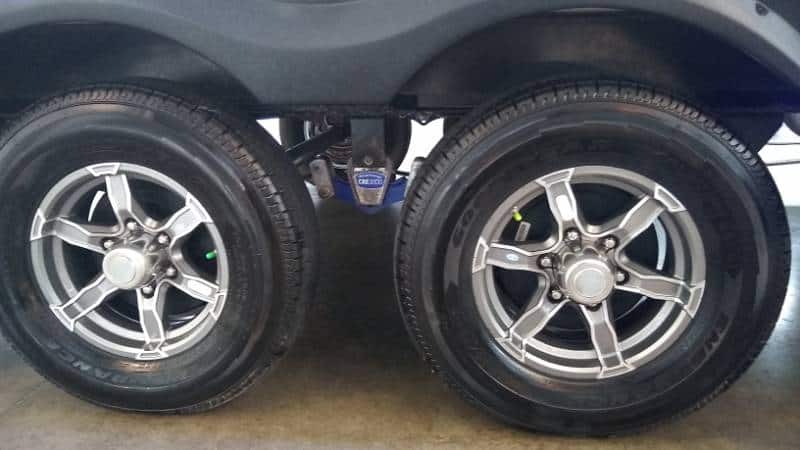
Finally, of course, check the tires. In fact, you should read the tire capacity on the sidewall, whip out your cell phone calculator, and make sure the total tire capacity is at least 10% more than the GAWR.
If you see painted steel rims, turn and run!
You can crawl out from underneath the camper now. Let’s go inside.
Quality Walk-Thru: INSIDE
Don’t get distracted here!
When shopping for a home, you usually judge build quality by the finishes and hardware: faucets, sinks, door handles, that sort of thing. That doesn’t work in an RV.
I can walk into 50 RVs, and I guarantee I’ll find the same faucet in 30 of them, whether they cost $28,000 or $128,000.
Some of the interior components, like bathroom faucets, are what I call “placeholders.” Most RV manufacturers don’t spend any extra money on them, regardless of how much the RV costs. If you want a solid bronze faucet, they reason, you’ll buy your own.
I also encourage you to ignore schmoozy gizmos and finishes like:
- Faux fireplaces
- Oversized sound bars
- Window valances
- LED cup holders
- Kitchen backsplashes
These fads rarely correlate to construction quality. They come and go with the latest trends. You need to look elsewhere.
LIVING ROOM
Let’s start with the living room floor.
Carpet is bad news. You want sheet vinyl or linoleum. You can add your own carpets. Unless the RV is built on a motorhome chassis, you should avoid tile.
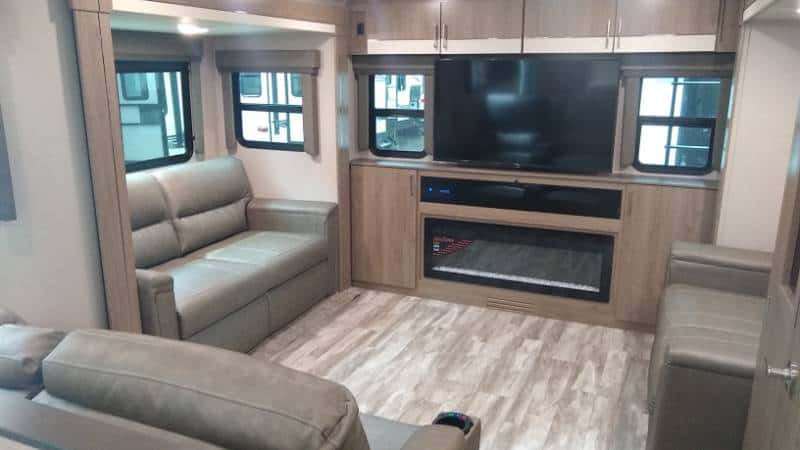
Count the number of outlets! If the manufacturer was stingy with the outlets, they were stingy with other components, too. Does every major seating area have access to power?
Inspect the dinette table leg system. You can even try to convert the dinette to a bed to see how it works. Swivel-leg, drop-leg and snap-on systems are indicators better quality than simple fixed pedestal legs.
Look up at the ceiling fans. Dinky 4-inch diameter fan = sweaty summer days. You want to see full-size fan blades that can exhaust a minimum of 350 cubic feet per minute – preferably 500 or better!

Even worse is if there’s no fan at all – just a roof opening with a lid.
If you can, unzip a dinette cushion and look inside. Is it just a cover surrounding the foam core, or did the manufacturer pay extra for batting? Is the foam dense or lightweight? Dense foam lasts significantly longer.
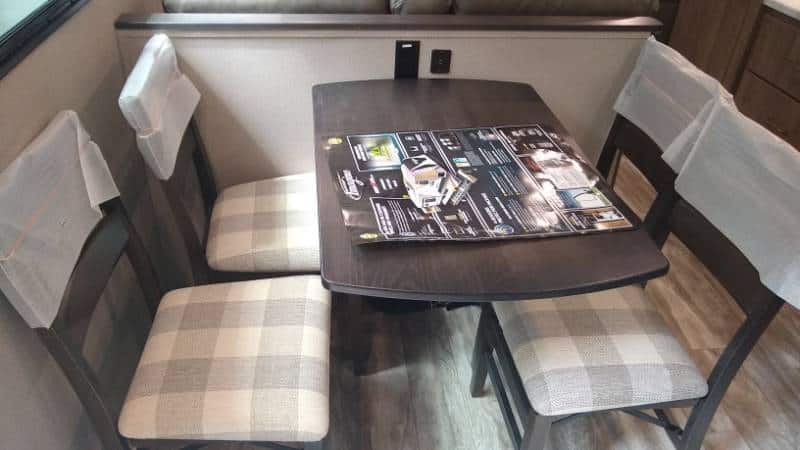
KITCHEN
How are the drawer boxes constructed? Do you see dovetailed or rabbeted corner joints, or just butt joints with 18-gauge staples or brad nails? Are the walls built with robust ⅜-inch or ½-inch plywood, or are they pieced together with cheap ¼-inch plywood?
Inspect the cabinet door joints. Are the rails and stiles butted together with cheap glue and extra-wide staples, or are they loose mortise and tenon joints?
Finally, look at the counter top material. Luxury units may have solid surface acrylic counters. Others may use residential-grade laminate (e.g. Formica).
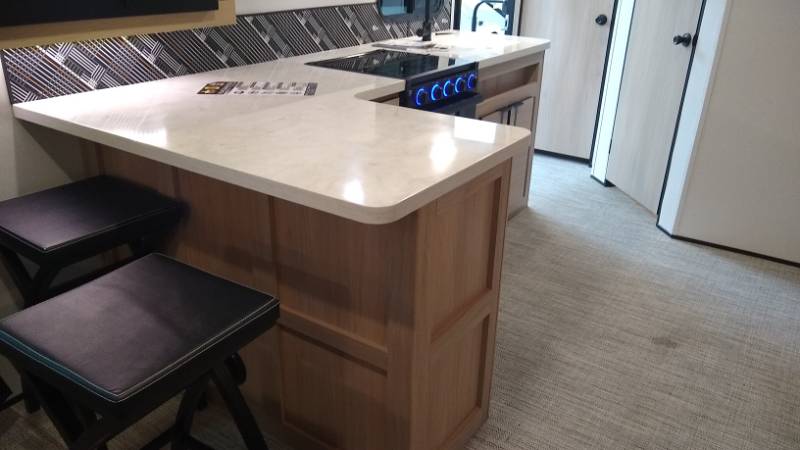
The typical counter is just particle board wrapped in HPL (high-pressure laminate). These counters are easily damaged by water intrusion at the joints. These counter tops should be seamless. You don’t want to see any joints.
Here’s a bonus: Most RVs use removable drawer slides. There’s a tab on each end that allows you to separate the slides. You can pull out the drawer and peek behind to see the mechanical innards.
Turn on your flashlight and inspect any PEX lines or wire harnesses you can see. Clean routing is good design. A rats’ nest of wires isn’t.
Bad news, folks. Unless you’re shopping high-end RVs, you want find any hardwood or cabinet-grade plywood in RV cabinets. You’re getting vinyl-wrapped particle board fastened with staples.
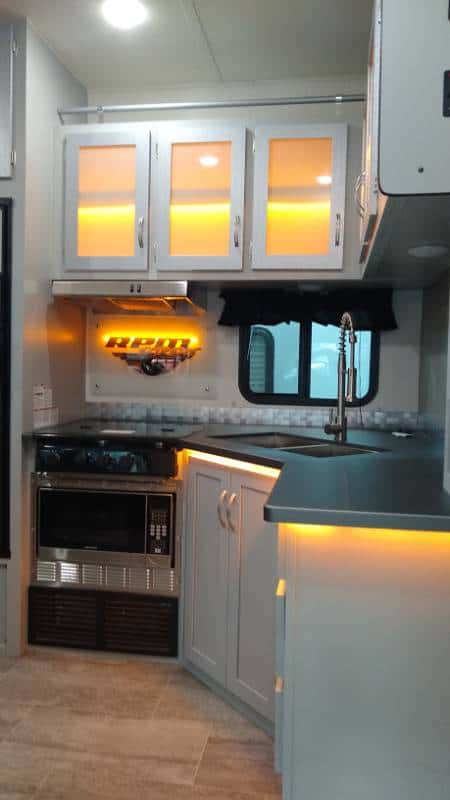
I like to see adjustable shelving systems. Fixed shelves are faster to build, but they don’t allow the customer to personalize their storage setup.
Press down on the drawer and shelf bottoms. A little flex is allowable. A lot is not. Lots of flex indicates that the manufacturer used cheap ⅛-inch plywood for the bottom (not good) or one of the long sides is insufficiently supported.
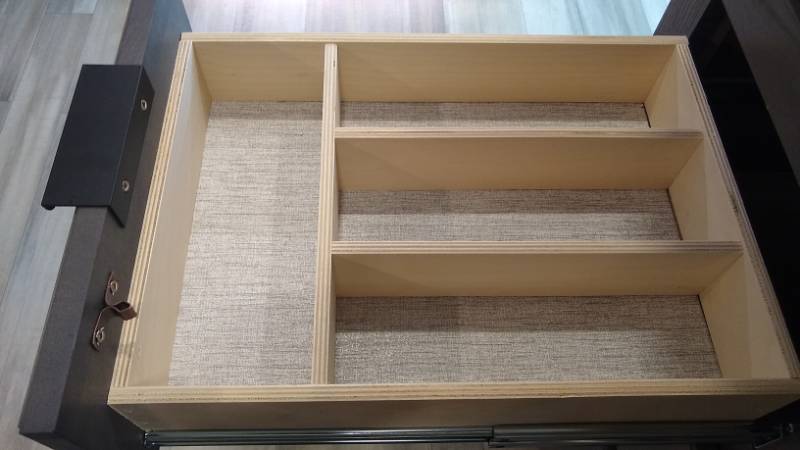
BEDROOM

Look at the mattress. And actually lay on the bed! That includes the bunk beds, too. Some of those bunk beds only have 2- or 3-inch foam toppers!
Now, don’t turn away from an RV just because you don’t like the mattress. Quite frankly, most RV manufacturers assume that you’ll upgrade the mattress on your own. It doesn’t make market sense to spend the extra money on a plush, premium mattress that everyone will love.
Do the bedroom windows come with blackout shades or curtains? If not, you’ll need to install some yourself.
Lift up the mattress. There’s usually a storage compartment underneath. How flimsy is the storage compartment lid? Does it have a gas strut to assist lifting? Are the hinges strong enough to hold the lid without twisting?
Again, count those outlets! Each bed should have His and Her storage cubbies and access to power, preferably both 120V and 12V.
Open the cabinets. Look for any exposed fastener heads, screw points or wood shavings. An RV should be fully vacuumed and cleaned out before departing the factory.
BATHROOM

Ah, the bathroom.
For signs of construction quality, you really only need to look at two things:
How much of the toilet is ceramic? If it’s uber-cheap, it’ll be 100% plastic. If it’s 100% porcelain, you’re in a luxury unit. Most toilets are somewhere in between with a ceramic bowl and plastic body.
If it has dual-flush compatibility, you’ve really hit the jackpot! If the RV has a macerator pump, you’re in the lap of luxury.
Now, look at the shower – most specifically, the shower pan.
How are the shower walls integrated with the shower pan? The cheapest units may not even have a true surround. Turn and run!
Most mid-grade units will either have a 3-sided enclosure or a panelized wall system. You want to verify the shower enclosure overlaps the vertical lip of the shower pan and is adhered/sealed on the backside.
Inspect the shower curtain hardware. Your typical entry-level shower has a curtain on a thin plastic track. These rip easily. Nicer RVs have sliding or folding glass doors.
It almost goes without saying, but actually stand in the shower! Sit down on the toilet! Make sure you fit! Especially if you’re 6’ 2” and above. Not all RVs or campers will accommodate your height.
APPLIANCES
Now, let’s examine a few of the appliances.
Is the air conditioner large enough for the interior? The rule of thumb is at least 1,000 BTUs per foot of RV body length.
If the floorplan has separate rooms, such as bedrooms, does each room have its own A/C, or is the A/C properly ducted? You want to avoid layouts where, for instance, the master bedroom doesn’t have its own reliable source of cool air conditioning.
Does the entertainment system have a built-in DVD player and Bluetooth capability? Or does it only have radio and USB functionality?
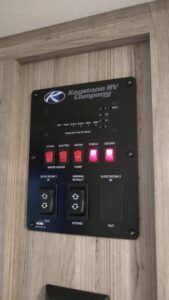
If you can peek behind the stereo head unit, see if the manufacturer ran cheap RCA or higher-quality HDMI cables from the stereo to the TV[s].
Is there an onboard inverter? That’s usually a sign that this rig is meant for serious duty, like full-time use. The bigger the inverter, the better. Aim for 3000+ watts for larger rigs, 1500 watts minimum for any RV.
Do you have a conventional or on-demand water heater? Instant water heaters are the way of the future, people!
Leave a Reply